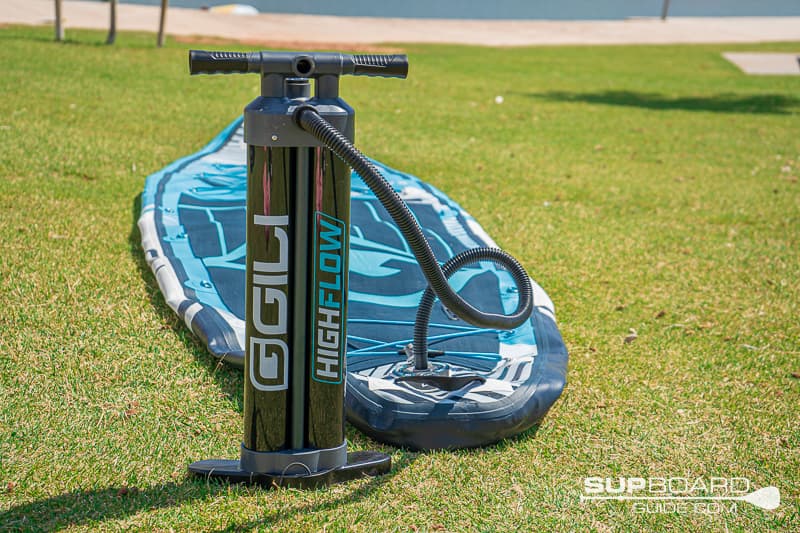
Inflatable paddle boards have a ton of great benefits that make them viable and fun to paddle on, but the major downside to using them is that you do have to take the time to inflate them. At SUPBoardGuide.com, our favorite and top recommended accessory for all paddleboard kits are electric pumps. Electric pumps will do the hard work of inflating your SUP for you in about the same time as a manual pump, have a deflation option as well, and are more compact in size compared to manual pumps. However, electric pumps are a pricey add-on, and you can’t use them if you don’t have anything to plug into. As such, sooner or later, you’re going to wind up having to rely on a manual pump.
To make your manual pumping experience as quick, easy, and painless as possible, here our some of our top tips when using a manual pump to inflate a SUP:
Tip #1: Make sure the inflation valve is closed before inserting your hose.
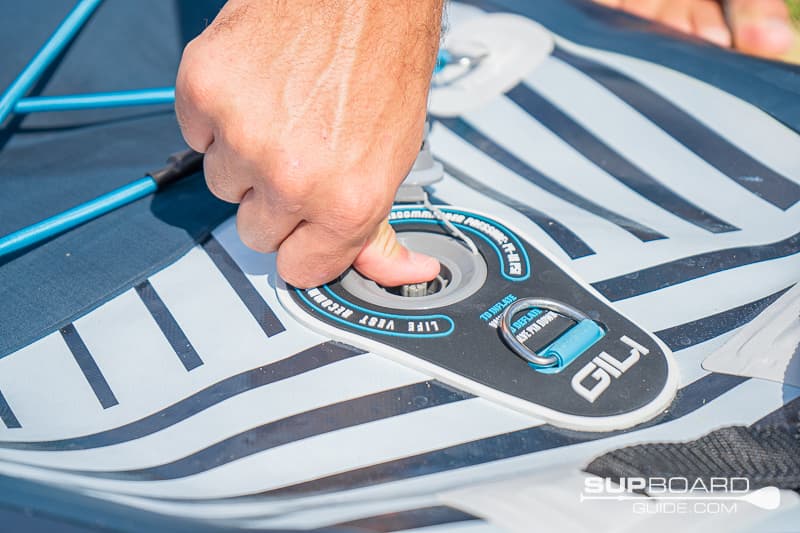
The most common mistake that every new and beginner paddle boarder makes (including us sometimes) is failing to make sure the inflation valve is in the right position before inserting your hose. The majority of paddleboards on the market rely on a Halkey-Roberts valve that is in the closed position when up and in the open position when pressed down and locked into place. When you insert your hose, you are pressing down and turning the valve position, but also turning it back when you retrieve your hose.
As such, if you insert your hose when the valve is up and closed, taking the pump hose out will leave the valve up and closed as well, your paddleboard ready for the water. Alternatively, if you insert your hose when the valve is down and open, taking the pump hose out will leave the valve down and open as well, letting out the air you just pumped out. Even if you try to fix your mistake quickly, it is likely that your SUP has just decreased by 2 to 4 PSI. As such, always make sure that your inflation valve is in the correct position before inserting your pump hose!
Tip #2: Use your whole body, not just your arms, to pump.
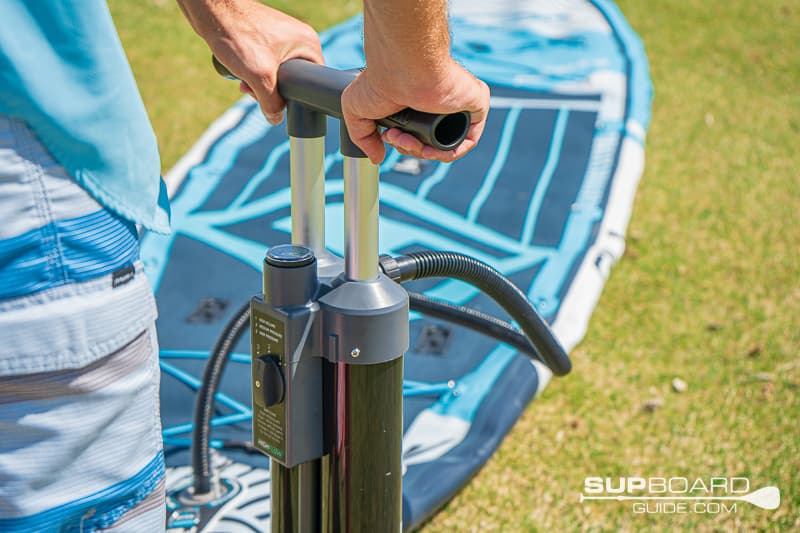
Paddleboards are built to be easy to pump for short and tall paddlers alike, but it does take the proper technique in order to quickly and efficiently pump up a paddleboard. Part of that technique involves using the proper form. If you find yourself taking more than fifteen minutes to inflate your paddleboard, it’s very likely that you aren’t making the most of your own body’s momentum to inflate your SUP.
So, to ensure you have the proper posture and technique, step onto the pump and make sure your shoulders are lined up perfectly over the manual pump’s handles. Bend down until you can comfortably grab the handles while keeping your arms straight, and start pumping only by collapsing and stretching out your legs. At no point in time should your elbows bend or your arms should tire out, so if they get worn out you know you’re doing it wrong. Just focus on letting your legs lift you up while relying on your body to fall and push down on the handles to get the air in. If you use this technique, not only will you find it easier to pump up your paddleboard, but you’ll probably shave at least a few minutes off your inflation time as well.
Tip #3: Understand the action modes on single and dual-chamber pumps.
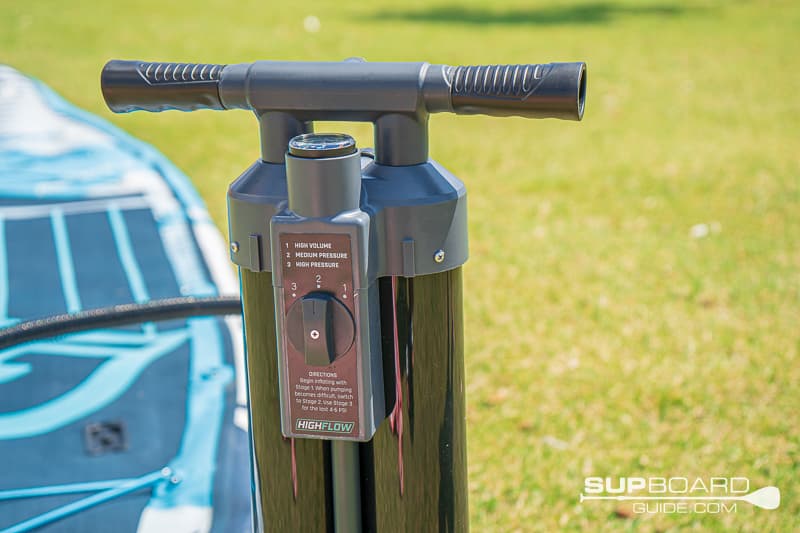
If you are using the manual pump that came with your paddleboard, odds are it is a single-chamber, dual-action pump or a dual-chamber, triple-action pump. Single-chamber pumps are lighter, easier to pack, and more simple to use, while dual-chamber pumps are more efficient and will help you inflate your board a few minutes quicker. Both of these pumps will make inflating paddleboards easy, but only if you understand the action modes and use them properly.
For a single-chamber pump, make sure you are in action mode one when you begin pumping. In action mode one, you will pump air into your paddleboard as you both push and pull on the pump handles. Action mode one is the quicker of the two action modes, and is generally useful till about 5 to 7 PSI, which is when you will encounter resistance and want to switch to action mode two. Action mode two allows you to pump air just when you push down on the handles, making it easy to pull the handles up while using your weight to get the air into the paddleboard. Keep the single-chamber pump in action mode two until your board is fully inflated, which we would recommend to be around the 12 to 15 PSI range.
Dual-chamber pumps are a bit more complicated, but the extra action mode ensures that you can pump a paddleboard up with fewer pumps once you know what you’re doing. In action mode one, you will inflate on both the rising pull and falling push of the pump handles in both of the dual chambers. Inflate in action mode one to about 5 PSI, which is when you will want to switch to action mode two. In action mode two, you will only pump air when you push down with the handles, but you will still be inflating in both of the pump’s dual chambers. Inflate in action mode two until you hit about 10 PSI or encounter heavy air resistance once more, which is when you will switch to the final action mode. In action mode three, you are pumping air only on the fall of your pump, and just in a single chamber, which results in the slowest but easiest pumping mode. Keep pumping until you’ve hit your desired PSI, and if you remembered to insert your hose after assuring the valve is in the up position, you’ll be ready to hit the water with your inflated SUP!
Side Note: Not all manual pumps are made alike.
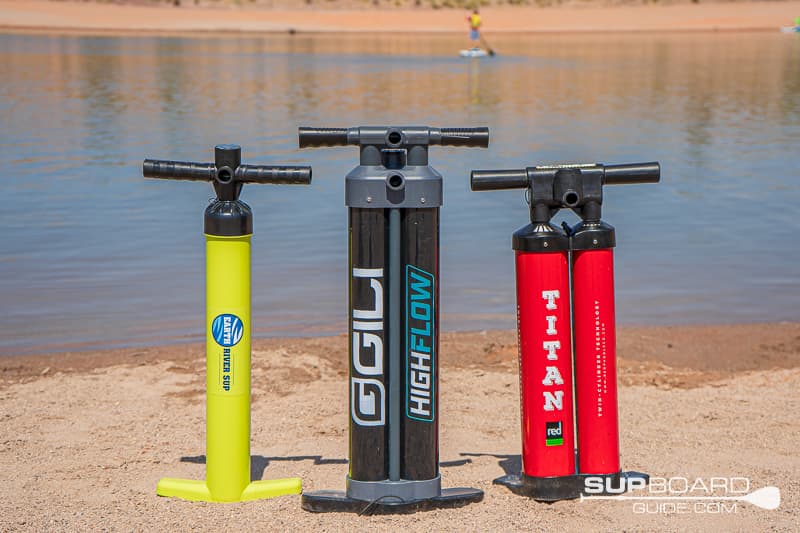
Generally, you are going to see the same performance when you compare single-chamber pumps with other single chamber pumps. From a broad point of view, you will also find most dual-chamber pumps to perform similarly to each other, with some key differences. These differences include:
- Deflation nozzles. Some dual-chamber pumps that have a deflation nozzle built in, allowing you to pump the last bits of air out of your SUP by hand and saving you time in the deflation process.
- Durability. Depending on what brand you go with, a dual-chamber pump may have parts that shatter or break easily, while others can take quite the beating and still work good as new.
- Portability. A few dual-chamber pumps actually come with their handles, stands, and other parts detached in order for you to have a smaller, more compact pump.
- Overall speed. The size of the chambers and how easy it is to pull on the pump will impact the overall speed, making some dual-chamber pumps between 20 to 30% quicker than inferior dual-chamber pumps.
No matter which dual-chamber pump you go with, the difference in overall efficiency and ability is minimal enough that we would recommend upgrading only to the most dedicated paddlers. In fact, if you are spending the money to upgrade your pump, we would recommend going with an electric pump instead. If you do want to stick with the best manual pump you can get, we recommend looking at the Red Paddle Co Titan Pump.
Conclusion: Pumping doesn’t have to be a pain.
Pumping up an inflatable SUP is generally our least favorite part of the paddleboarding experience, but it doesn’t have to be a painful one. By following the tips we’ve suggested above, you’ll be able to get your paddleboard ready for the water in less than ten minutes and without breaking a sweat. Furthermore, if you’ve forgotten what you’ve read here, many paddleboard manual pumps have tips and recommended steps of use printed right on the outside of the pump’s chamber! Just remember to insert the hose properly, maintain your proper posture, and use the action modes correctly, and you’ll be able to inflate your paddleboard in no time at all.
Thank you so much for reading! We hope this guide has been helpful to you. If you have any questions about manual pumps, or would like our opinion on a particular pump or paddleboard you’re looking at, feel free to leave a comment below or send us an email! We love to talk paddleboards, from the SUPs themselves to the recommended gear and different sports you can use them for, and are working hard to publish other SUP guides like this as well. If there is something you need help with trying to understand when it comes to paddleboards, be sure to let us know!
And remember to have fun SUPing!
SupBoardGuide
Latest posts by SupBoardGuide (see all)
- Best Paddle Boards for Beginners, 2025 - July 3, 2025
- Hala Radito Whitewater iSUP Review – 2025 - June 27, 2025
- Hala Atcha 96 Whitewater iSUP Review – 2025 - June 16, 2025






